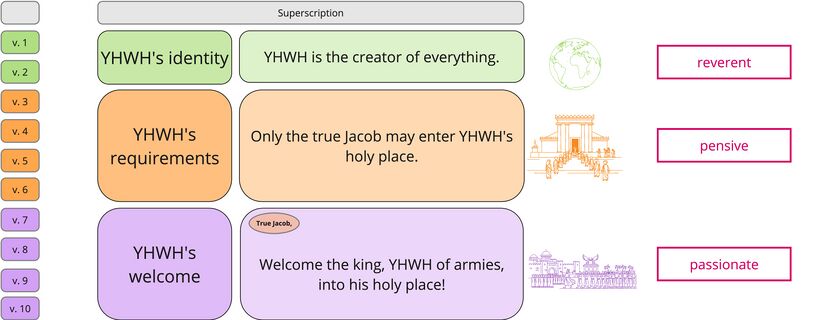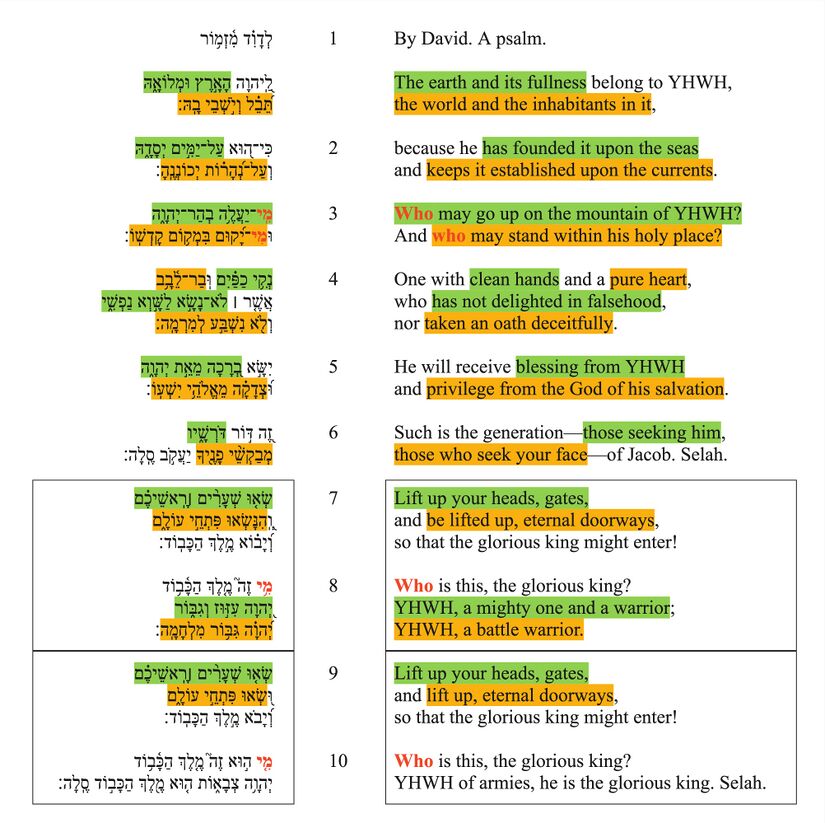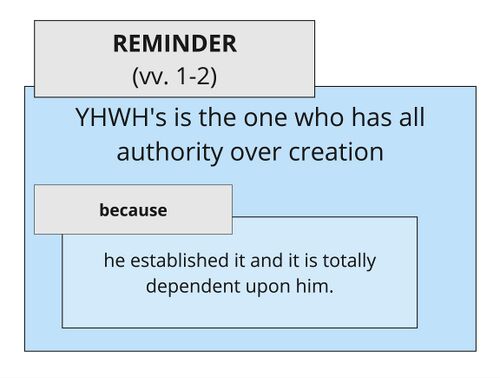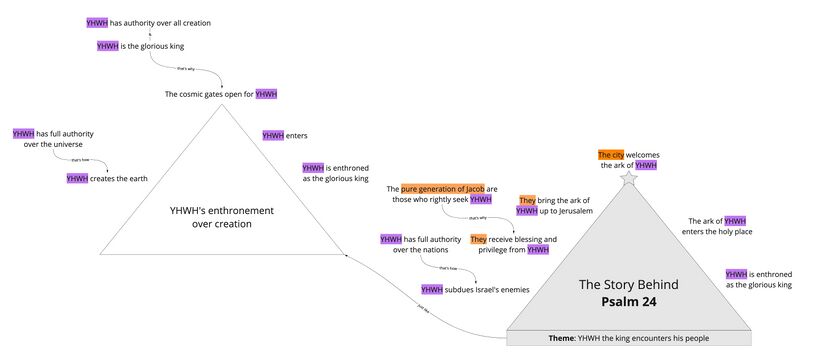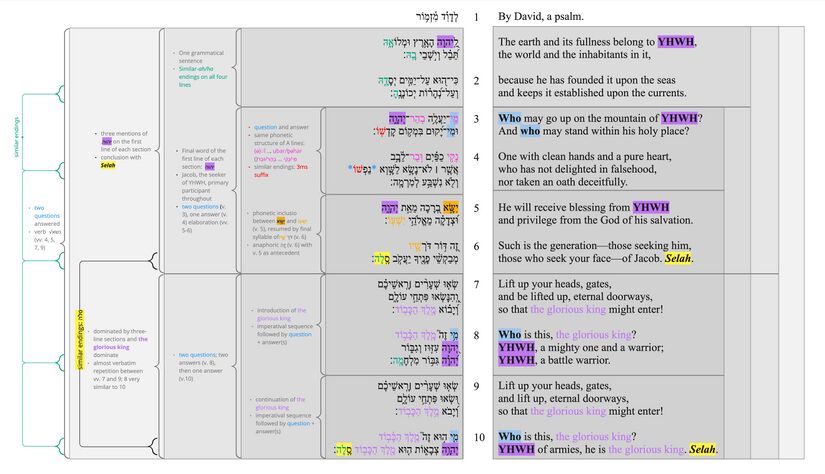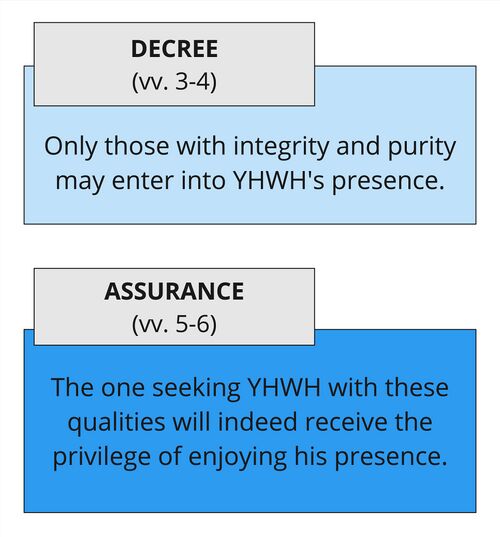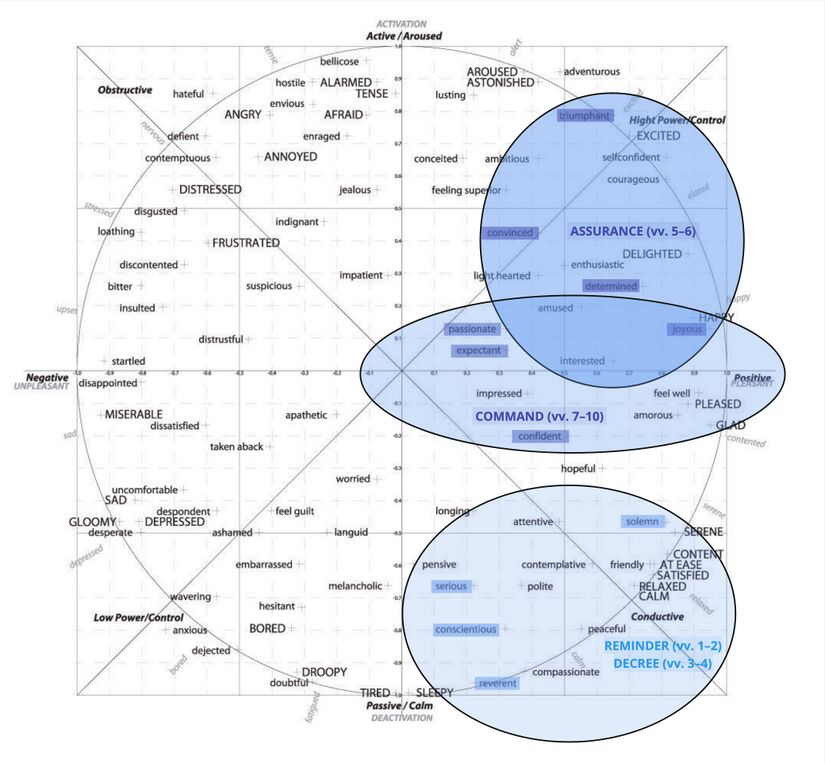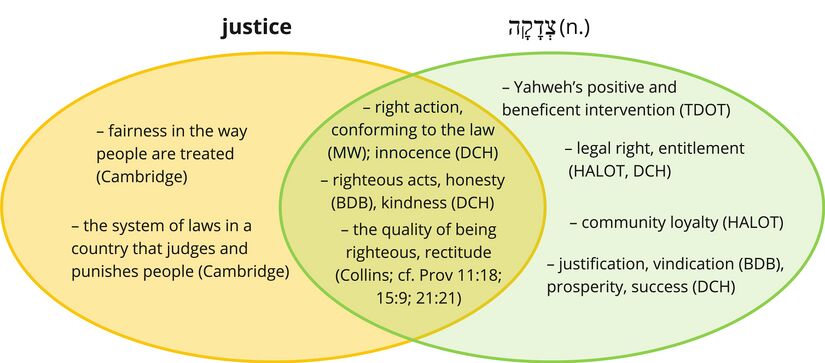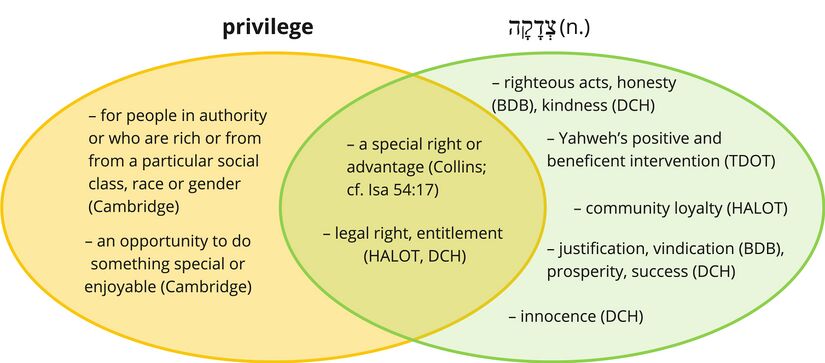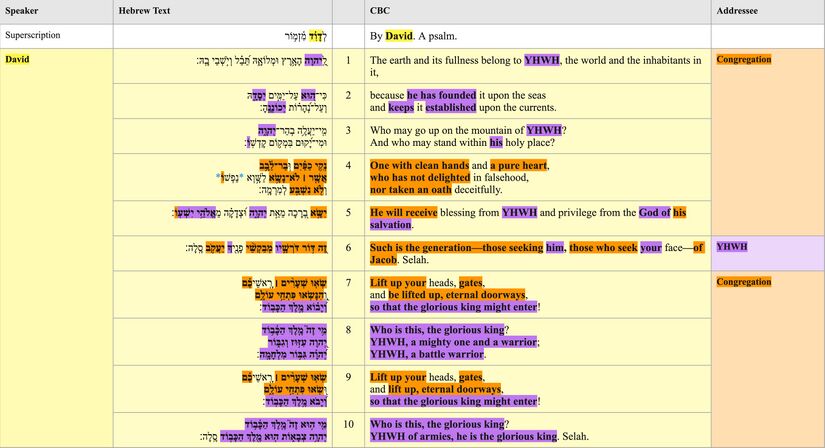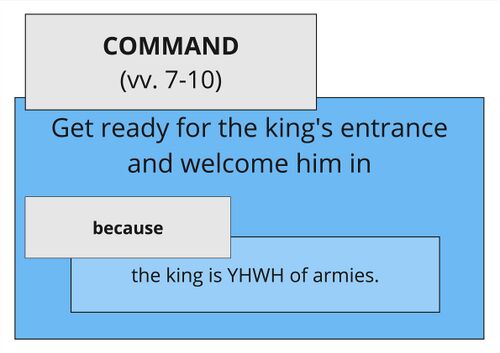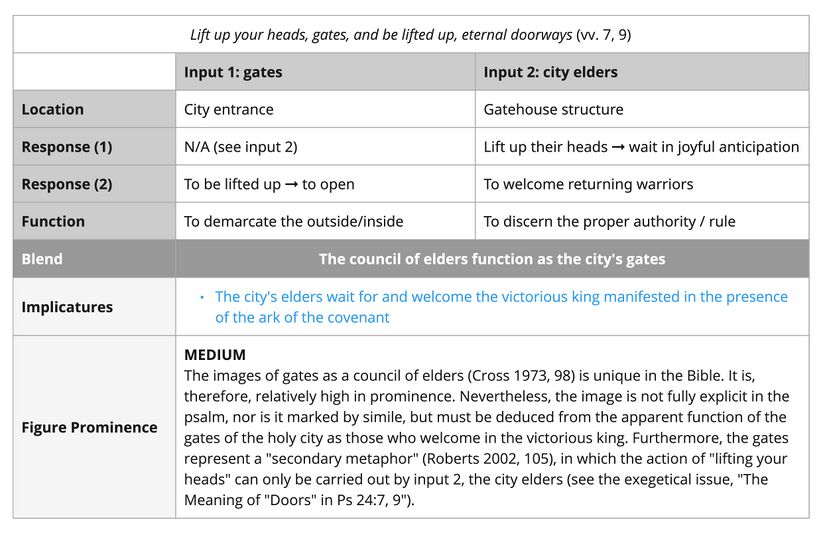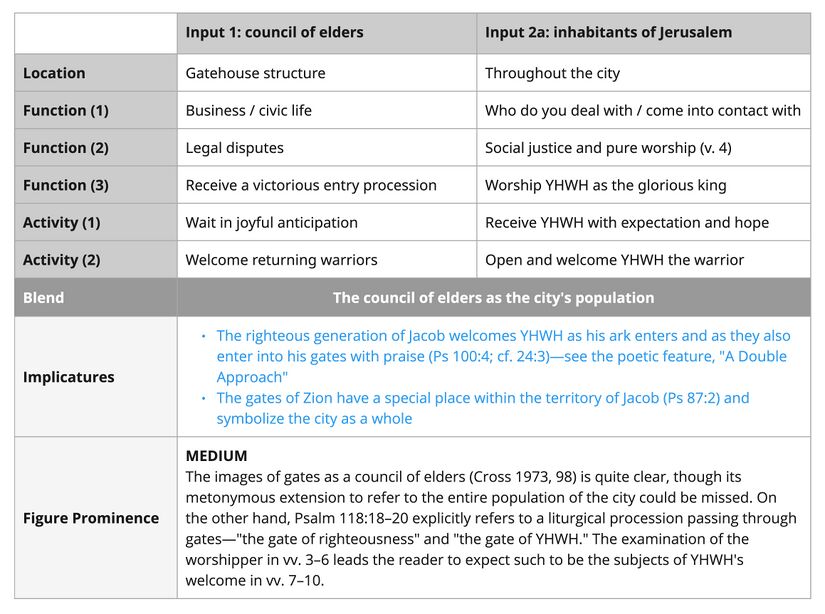Psalm 24 Verse-by-Verse
Welcome to the Verse-by-Verse Notes for Psalm 24!
The Verse-by-Verse Notes present scholarly, exegetical materials (from all layers of analysis) in a verse-by-verse format. They often present alternative interpretive options and justification for a preferred interpretation. The Verse-by-Verse Notes are aimed at consultant-level users.
The discussion of each verse of this psalm includes the following items.
- A link to the part of the overview video where the verse in question is discussed.
- The verse in Hebrew and English.[1]
- An expanded paraphrase of the verse.[2]
- A grammatical diagram of the verse, which includes glosses for each word and phrase.[3]
- A series of notes on the verse, which contain information pertaining to the interpretation of the psalm (e.g., meaning of words and phrases, poetic features, difficult grammatical constructions, etc.).
Introduction
Psalm 24 divides into three parts: YHWH's Identity (vv. 1–2), YHWH's Requirements (vv. 3–6) and YHWH's Welcome (vv. 7–10).
It is difficult, at first, to see how these three parts fit together into a coherent whole. How do the requirements (vv. 3–6) fit in with the cosmic view of YHWH's identity as creator and sustainer of all (vv. 1–2) and the welcome to open the gates (vv. 7–10)? The historical background to Psalm 24 is crucial to understand both its message and coherence. We believe the connection between YHWH's requirements and the rest of the psalm is found in the entrance of the ark of the covenant to Jerusalem, as read in 2 Samuel 6, which is massively informed by the failures of the preceding "Ark Narrative" found in 1 Samuel 4–7:2.[4] The expansions in our paraphrase throughout the page draw out this connection and link the requirements to join in the procession of accompanying the Ark (vv. 3–6) to the procession itself (vv. 7–10).
We imagine the psalm being recited against the background of the following series of events:

The necessary background ideas to have in mind are the following:
- YHWH created everything and assumed his position of rest in his cosmic temple (Pss 95:11; 96:5-6; 99:1-2, 5, 9), displaying his authority and sovereignty over all creation (Gen 1:1; Pss 89:9-12; 90:2; 93:4; 95:3-5).
- Mount Zion represents both the center of creation and the temple-city of YHWH's special presence (Isa 2:1-5; Mic 4:1-2; Ps 99:5, 9).
- The Israelites had a history of trying to manipulate the ark and to worship according to their own understanding, not recognizing the boundaries of YHWH's holiness (1 Sam 4:1-7:2; 2 Sam 6:1-11).
As discussed in the poetic feature, A double approach, the entire message of the psalm is structured and packaged as two meetings between YHWH and his people, as they approach his mountain (vv. 3–6) and he approaches his holy place (vv. 7–10). Almost all of the content in Ps 24 is made up of pairs on various structural levels. This ranges from individual noun phrases, in the case of vv. 1, 4a and 6, to clauses, as in vv. 2, 3, 4, etc., and even to full sections, in the case of the symmetry between vv. 7-8 and vv. 9-10. The two "Who...?" questions of v. 3 are matched by the those of vv. 8 and 10. Although the questions of vv. 8 and 10 could also be considered a pair, within their own poetic sections they are structurally independent, so they actually break the pattern in their respective verses. Besides these latter "Who...?" questions, the only full lines left out of this pattern of pairs are the weyiqtol clauses of v. 7c and v. 9c, and the final verbless clause of v. 10.
Although parallelism is the hallmark of Biblical Hebrew poetry and thus expected to be common, its structural function in Psalm 24 is far from average. Iconically, it effectively represents the two sides of a reciprocal approach in the psalm: on the one hand, by the human king and his people towards YHWH in vv. 3–6, and on the other hand, the glorious king, YHWH, towards his people in vv. 7–10. Where the pattern is broken, perhaps by the final two "Who...?" questions, but more clearly by the weyiqtol clause in both v. 7c and v. 9c, and most certainly by the uniqueness of the final line of the psalm, we are led to the climax of this glorious king's entrance as "YHWH of armies" (יְהוָה צְבָאוֹת). Indeed, the "For what?" of the two imperatives in vv. 7a-b and 9a-b are important enough to say "so that the glorious king might enter" (וְיָבוֹא מֶלֶךְ הַכָּבוֹד) twice, which leads to the question, "Well, who is he?" twice. This question is answered twice in v. 8, while "YHWH of armies" in the second line of v. 10, the only two-line section in vv. 7-10, is sufficient closure.
YHWH's Identity (vv. 1–2)
Verses 1–2 provide a thematic introduction to the rest of the psalm by reminding the listener of YHWH's identity as creator and sustainer of everything:
Indeed, in the same way one could describe YHWH's "enthronement" over creation, the entrance of his Ark symbolizes the same enthronement upon his temple-mount in Zion:
v. 1
| Hebrew | Verse | English |
|---|---|---|
| לְדָוִ֗ד מִ֫זְמ֥וֹר | 1a | By David. A psalm. |
| לַֽ֭יהוָה הָאָ֣רֶץ וּמְלוֹאָ֑הּ | 1b | The earth and its fullness belong to YHWH, |
| תֵּ֝בֵ֗ל וְיֹ֣שְׁבֵי בָֽהּ׃ | 1c | the world and the inhabitants in it, |
Expanded Paraphrase The words in <i>italics</i> provide a fuller sense of the psalm; the text itself is in <b>bold</b>.
Notes
- Verse 1 reminds the audience that YHWH enjoys sole ownership of all creation. All of it, without exception, belongs to him and him alone.
- See our discussion of the lamed in By David (לְדָוִד) here.[5]
- This verse contains the first mention of YHWH in the psalm, who appears once in each poetic sub-section, though twice in v. 8.
- The lamed preposition in to YHWH (לַיהוָה) indicates possession,[6] i.e., the earth and its fulness are to YHWH ➞ the earth and its fulness belong to YHWH. Although it is standard, both in Biblical Hebrew and cross-linguistically, for the possessee to appear first in a predicational possessive clause,[7] the order is reversed here for the pragmatic function of exclusive focus: "they belong only to YHWH," as reflected in our macrosyntactic analysis:
- The waw in The earth and its fullness communicates addition, though the idea is probably more accurately portrayed by the preposition with, as read in the Peshitta's "the earth with its fullness."[8]
- While the earth (הָאָרֶץ), as a unique referent, has an article, its parallel counterpart the world (תֵּבֵל) does not, apparently considered definite as "a common noun that has acquired the value of a proper noun."[9]
- The construct chain rendered the inhabitants in it (וְיֹשְׁבֵי בָהּ) contains a prepositional phrase (בָהּ) as its dependent. As noted by GKC, "The construct state ... is frequently employed ... as a connecting form, even apart from the genitive relation; so especially - (1) Before prepositions, particularly in elevated (prophetic or poetic) style."[10]
v. 2
| Hebrew | Verse | English |
|---|---|---|
| כִּי־ה֭וּא׀ עַל־יַמִּ֣ים יְסָדָ֑הּ | 2a | because he has founded it upon the seas |
| וְעַל־נְ֝הָר֗וֹת יְכוֹנְנֶֽהָ׃ | 2b | and keeps it established upon the currents. |
Expanded Paraphrase The words in <i>italics</i> provide a fuller sense of the psalm; the text itself is in <b>bold</b>.
Notes
- Verse 2 provides the explanation of the reminder in the previous verse: the whole world belongs to YHWH because he created it in the first place and continues to sustain it. Though waters do not make for a very stable foundation, it is by YHWH's power that the world is stable and will not waver (Pss 93:1; 96:10; 104:5).
- Supporting the previous proposition, this verse's because (כִּי) clause(s) have a fronted pronoun he (הוּא), functioning as either polar focus (i.e., "It was he who...") or exclusive focus.[11] This is reflected in the paraphrase in our macrosyntax layer:
- Furthermore, the prepositional phrases upon the seas (עַל־יַמִּים) and upon the currents (עַל־נְהָרוֹת) are fronted to create a poetic pattern of repetition, which concludes the first section of the psalm, vv. 1–2.
- It is entirely plausible that the tense switching between qatal and yiqtol in the present verse is not intended to be semantic, but poetic, in order to conclude the poetic section of vv. 1-2 (in similar manner to the constituent order pattern, as noted above). In this case, both verbs should be understood as past perfective, as, e.g., the NIV: "for he founded it on the seas and established it on the waters" (cf. the LXX and Jerome). On the other hand, it is also possible to maintain the expected imperfective aspect of the yiqtol, as our preferred interpretation: keep it established.[12]
- Although it is a common word for "rivers,"[13] in cosmic contexts, such as in this verse, the word נְהָרוֹת refers to "sea currents".[14] See also Pss 89:26; 93:3 and Jonah 2:4[3]: "You hurled me into the depths, into the very heart of the seas, and the currents swirled about me (וְנָהָר יְסֹבְבֵנִי); all your waves and breakers swept over me" (NIV).
- Though seas (יַמִּים) and currents (נְהָרוֹת) do not have an article, they are considered definite as unique cosmological entities (see CSB, ESV, NASB, NIV, among others).
- As a lexical pair, both יַמִּים and נְהָרוֹת were known as Yammu and Naharu in Ugaritic literature. Both are mentioned as gods defeated by Ba'lu, in the same context in which Ba'lu encouraged the assembly of gods to lift up their heads.[15]
YHWH's Requirements (vv. 3–6)
Moving on from the reminder of YHWH's identity (vv. 1–2), this new section (vv. 3–6) contains two global speech acts: decree and assurance.
The emotions of the psalm take a shift after v. 4, from solemn reverence to thankful confidence and hope.
v. 3
| Hebrew | Verse | English |
|---|---|---|
| מִֽי־יַעֲלֶ֥ה בְהַר־יְהוָ֑ה | 3a | Who may go up on the mountain of YHWH? |
| וּמִי־יָ֝קוּם בִּמְק֥וֹם קָדְשֽׁוֹ׃ | 3b | And who may stand within his holy place? |
Expanded Paraphrase The words in <i>italics</i> provide a fuller sense of the psalm; the text itself is in <b>bold</b>.
Notes
- Just as the earth cannot be moved, neither can YHWH's holy mountain, Zion (Pss 46:6; 125:1; cf. Ps 78:69). Nevertheless, v. 3 decrees that not everyone may approach YHWH's holy place.
- The pair of Who (מִי) questions in this verse provides a significant component to the psalm's poetic structure (see the visual in the introduction above).
- Such questions are necessary as there had been a history of the Israelites (and, indeed, the Philistines) trying to manipulate the presence of the ark. This history, including Hophni, Phineas and the Israelite army (1 Sam 4), the Philistines (1 Sam 5–6), the people of Beth-Shemesh (1 Sam 6:19), and Uzzah (2 Sam 65–8) is visualized in the background events of the psalm (see the introduction above). Thus, the psalm's emotions continue those of solemnity, zeal, and reverence, also found in vv. 1–2.
- The questions provide a challenge and set up a decree regarding the requirement of these participants, not a real question. So we have an indirect speech act, just as in the following "Who...?" questions of vv. 8 and 10.
- Both yiqtol verbs in this verse should be understood as permissive (can, may, should), as reflected in our CBC: "Who may go up...?"[16]
- The parallelism between these two lines makes it probable that the mountain of the YHWH and his holy place are co-referential, as the mountain-city. Such seems clear from other places in the Psalter, such as Psalm 48:2, "in the city of our God, his holy hill" (בְּעִיר אֱלֹהֵינוּ הַר־קָדְשׁוֹ).
- As in many instances of a triple constituent construct chain terminating in a pronominal suffix, so in the case of בִּמְקוֹם קָדְשׁוֹ, "a pronominal suffix can be attached to the nomen rectum [construct dependent] where such a pronoun relates to the entire construct phrase, effectively to the nomen regens [construct head]."[17] Thus, the phrase should be understood as in his holy place, not in the place of his holiness.[18]
v. 4
| Hebrew | Verse | English |
|---|---|---|
| נְקִ֥י כַפַּ֗יִם וּֽבַר־לֵ֫בָ֥ב | 4a | One with clean hands and a pure heart, |
| אֲשֶׁ֤ר ׀ לֹא־נָשָׂ֣א לַשָּׁ֣וְא נַפְשׁוֹ | 4b | who has not delighted in falsehood, |
| וְלֹ֖א נִשְׁבַּ֣ע לְמִרְמָֽה׃ | 4c | nor taken an oath deceitfully. |
Expanded Paraphrase The words in <i>italics</i> provide a fuller sense of the psalm; the text itself is in <b>bold</b>.
Notes
- Verse 4 answers the question of the previous verse and decrees that only those with ethical integrity and religious purity will be allowed to YHWH's holy place.
- The descriptions in this verse provide the answer to the two "Who..." questions in v. 3. Grammatically, the overt predication "may go up on the mountain of YHWH and may stand in his holy place" has been elided.
- Both construct chains clean hands and a pure heart (נְקִי כַפַּיִם וּֽבַר־לֵבָב) communicate a relationship of specification, i.e., with regard to[19] ➞ "one with clean hands."[20] Compare, for example, "forgiven with regard to offense, covered with regard to sin" (נְשׂוּי־פֶּשַׁע כְּסוּי חֲטָאָה; Ps 32:1) and "blameless with regard to their way" (תְמִימֵי־דָרֶךְ; Ps 119:1), among others.
- In light of the third line, whose contextual domain is that of deceitful swearing, the sense of שָׁוְא as falsehood has been preferred here, rather than that of "futility" or "delusion,"[21] or even "idols." See further the Venn diagram and the discussion in the exegetical issue, The Text and Meaning of Ps 24:4b.[22] Right worship involves ethical integrity and religious purity, and so it avoids idolatry, to which both falsehood (שָׁוְא) and deceit (מִרְמָה) can refer.
- On the text and semantics of the second line of this verse, see the exegetical issue The Text and Meaning of Psalm 24:4b. We conclude that the expression "lift up one's soul" means delight in (*נָשָׂא לַשָׁוְא *נַפְשׁוֹ).[23]
- The use of the word "lift up" (נשׂא) in this construction is the first of six instances of this verb in the psalm, which constitute a large part of the poetic feature Lift up.
v. 5
| Hebrew | Verse | English |
|---|---|---|
| יִשָּׂ֣א בְ֭רָכָה מֵאֵ֣ת יְהוָ֑ה | 5a | He will receive blessing from YHWH |
| וּ֝צְדָקָ֗ה מֵאֱלֹהֵ֥י יִשְׁעֽוֹ׃ | 5b | and privilege from the God of his salvation. |
Expanded Paraphrase The words in <i>italics</i> provide a fuller sense of the psalm; the text itself is in <b>bold</b>.
Notes
- Verse 5 assures the person who meets the qualifications decreed in the previous verses that he/she may approach YHWH's holy place, which involves the blessing of proximity to YHWH's ark and the privilege of being involved in the entrance procession of the ark.
- Though possibly read as modal yiqtol, יִשָׂא is best read as future indicative, he will receive, as forming part of the confident claim and description of this person in vv. 3-4. Those ancient versions which do not contain the same ambiguity as the MT have an indicative verb,[26] and its parallel in Psalm 15:5 also supports this interpretation. At the same time, in terms of perlocution, the indicative nature of the clause "functions to call its readers to become Jacob,"[27] as discussed in the next verse.
- There is little apparent difference between the two instances of from (מֵאֵת and מִן) in the present verse, rendered identically, for example, in the LXX, Jerome's iuxta Hebraeos and the Peshitta,[28] as well as modern translations. It may be hypothesized that the compound מֵאֵת is to be construed as communicating both the origin and comitative nature of the "blessing" (בְרָכָה) as from with YHWH, though this is not a certainty.
- Although privilege is not a common gloss of צְדָקָה, in the present context, both צְדָקָה and the preceding blessing (בְּרָכָה) result in a person's permission to enter YHWH's presence: "The person who is 'conferred' with integrity automatically becomes part of the 'community of his seekers.'"[29] See further the following Venn diagrams, which compare the glosses "justice" and privilege" for צְדָקָה.[30]
- The mention of the God of his salvation activates the background events of the previous subduing of Israel's enemies, including both the Philistines and the Jebusite inhabitants of Jerusalem, as discussed in the introduction above.
v. 6
| Hebrew | Verse | English |
|---|---|---|
| זֶ֭ה דּ֣וֹר דֹּרְשָׁ֑יו | 6a | Such is the generation—those seeking him, |
| מְבַקְשֵׁ֨י פָנֶ֖יךָ יַעֲקֹ֣ב סֶֽלָה׃ | 6b | those who seek your face—of Jacob. Selah. |
Expanded Paraphrase The words in <i>italics</i> provide a fuller sense of the psalm; the text itself is in <b>bold</b>.
Notes
- Verse 6 confirms that the blessing and privilege described in the previous verse characterizes those who seek YHWH in the present generation.
- This verse concludes the first of two major macrosyntactic units, primarily indicated by Selah (סֶלָה) at the end of the verse and the shift to a chain of imperatives in v. 7. Further, the final global speech act, the command, spans vv. 7–10, following the assurance of vv. 5-6.
- The Such (זֶה), which begins the verse, communicates the manner function of the demonstrative,[31] as attested cross-linguistically.[32]
- For the alternative readings of the syntax of this verse, see the exegetical issue, The Text, Grammar, and Meaning of Psalm 24:6.[33] Our preferred reading involves Vertical Grammar, such that Jacob in the second line modifies generation in the first line and the entire verse reads
- This is the generation of Jacob,
- those who seek him
- those who seek your face.[34]
- For the text of "god of," present in a number of modern translations, see the discussion in The Text, Grammar, and Meaning of Psalm 24:6. Nevertheless, according to our preferred view of reading Jacob, instead of God of Jacob, "v. 6 functions to point out who the true Jacob really is, the implication being that there are other proposals that need to be rejected (ones that draw on ethnicity or place of residence as primary markers of election, for example)."[35]
- This verse is uniquely addressed to YHWH, as indicated by the second-person suffix on your face. The rest of the psalm is judged to be addressed to the congregation in general.
YHWH's Welcome (vv. 7–10)
As discussed above, the final Selah of v. 6 indicates a significant discourse boundary in the psalm. This is confirmed by the fourth and final speech act of vv. 7–10:
Throughout vv. 7–9 the line-length pattern is dominated by three-line verses, elsewhere appearing only in v. 4.
v. 7
| Hebrew | Verse | English |
|---|---|---|
| שְׂא֤וּ שְׁעָרִ֨ים ׀ רָֽאשֵׁיכֶ֗ם | 7a | Lift up your heads, gates, |
| וְֽ֭הִנָּשְׂאוּ פִּתְחֵ֣י עוֹלָ֑ם | 7b | and be lifted up, eternal doorways, |
| וְ֝יָב֗וֹא מֶ֣לֶךְ הַכָּבֽוֹד׃ | 7c | so that the glorious king might enter! |
Expanded Paraphrase The words in <i>italics</i> provide a fuller sense of the psalm; the text itself is in <b>bold</b>.
Notes
- Verse 7 characterizes the city of Jerusalem as its gates, who are exhorted to open and welcome in their victorious, glorious king, who has been their victor in salvation in battle over both human and cosmic enemies.
- The second member of the construct chain פִּתְחֵי עוֹלָם (both here and in v. 9) communicates characteristic, i.e., "doorways of eternity" ➞ eternal doorways.[36] For a full discussion of the identity of the doors, see the exegetical issue, The Meaning of "Doors" in Ps 24:7, 9. In short, they seem to be metaphorical for the elders of the city, who represent the city's entire population, as explored in the following two imagery tables:[37]
- For the result interpretation of the weyiqtol so that ... might enter (וְיָבוֹא), as well as that in v. 9, see, e.g., the JPS: "so the King of glory may come in!"[38]
v. 8
| Hebrew | Verse | English |
|---|---|---|
| מִ֥י זֶה֮ מֶ֤לֶךְ הַכָּ֫ב֥וֹד | 8a | Who is this, the glorious king? |
| יְ֭הוָה עִזּ֣וּז וְגִבּ֑וֹר | 8b | YHWH, a mighty one and a warrior; |
| יְ֝הוָ֗ה גִּבּ֥וֹר מִלְחָמָֽה׃ | 8c | YHWH, a battle warrior. |
Expanded Paraphrase The words in <i>italics</i> provide a fuller sense of the psalm; the text itself is in <b>bold</b>.
Notes
- Verse 8 challenges the congregation to carefully consider the identity of this glorious king, who is no less than a mighty battle warrior, subduing all the people's enemies and reigning from his temple-mount.
- There are three possible ways to read the syntax of the first line of this verse (מִי זֶה מֶלֶךְ הַכָּבוֹד). Our preferred reading reflects right-dislocation of this glorious king (מֶלֶךְ הַכָּבוֹד) after the demonstrative pronoun this (זֶה).
- Other options include interpreting זֶה as an interrogative clitic, "Who is (מִי זֶה)...?" or as an adnominal demonstrative, "this glorious king" (זֶה מֶלֶךְ הַכָּבוֹד). Although popular among modern translations, these interpretations of the syntax are not persuasive and have been rejected for a number of reasons.[39]
- Just as in v. 3 above, the interrogative is probably not a real question, but an indirect speech act providing a directive, to challenge the hearer to engage in proper reflection on YHWH's identity.
v. 9
| Hebrew | Verse | English |
|---|---|---|
| שְׂא֤וּ שְׁעָרִ֨ים ׀ רָֽאשֵׁיכֶ֗ם | 9a | Lift up your heads, gates, |
| וּ֭שְׂאוּ פִּתְחֵ֣י עוֹלָ֑ם | 9b | and lift up, eternal doorways, |
| וְ֝יָבֹא מֶ֣לֶךְ הַכָּבֽוֹד׃ | 9c | so that the glorious king might enter! |
Expanded Paraphrase The words in <i>italics</i> provide a fuller sense of the psalm; the text itself is in <b>bold</b>.
Notes
- Verse 9 repeats the welcoming exhortation of v. 7.
- The only difference between v. 7 and v. 9 is the consistent use of the qal stem for the two imperatives lift up (שְׂאוּ... וּשְׂאוּ), whereas v. 7 switches to a niphal in its second case: "be lifted up."[40] Radak suggests that the object "your heads" has been elided in the second line.[41]
- In any case, we have here the final two instances of the root נשׂא, as discussed in the poetic feature, Lift up (see v. 4 above).
- For the result interpretation of the weyiqtol so that ... might enter (וְיָבוֹא), as well as that in v. 7 above, see, e.g., the JPS: "so the King of glory may come in!"[42]
v. 10
| Hebrew | Verse | English |
|---|---|---|
| מִ֤י ה֣וּא זֶה֮ מֶ֤לֶךְ הַכָּ֫ב֥וֹד | 10a | Who is this, the glorious king? |
| יְהוָ֥ה צְבָא֑וֹת ה֤וּא מֶ֖לֶךְ הַכָּב֣וֹד סֶֽלָה׃ | 10b | YHWH of armies, he is the glorious king. Selah. |
Expanded Paraphrase The words in <i>italics</i> provide a fuller sense of the psalm; the text itself is in <b>bold</b>.
Notes
- Verse 10 repeats the challenge of v. 8—that the congregation carefully consider the identity of this glorious king—though here they are challenged to slow down further and reflect more deeply. It turns out that this glorious king is YHWH of armies, sovereign creator and sustainer of everything, the warrior who dwells between the cherubim and accompanies the ark (1 Sam 4:4; 2 Sam 6:2).
- Regarding the phrase Who is this...? (מִי הוּא זֶה), see grammar notes above for v. 8. Although interrogative clitics are widely attested for the demonstrative זֶה (despite the prosodic indications that this is not the case in v. 8), this would be a unique attestation of an independent pronoun compounding onto מִי זֶה for the same effect, and even falling in between: מִי הוּא זֶה! Rather, this construction should be understood as a tripartite copular clause, with the so-called pronominal copula הוּא. Further, the conjunctive accents between these three constituents, yet disjunctive on the clause-final זֶה, supports this reading. Compare the pattern found in "The Lord is righteous" (צַדִּיק הוּא יְהוָה; NIV) in Lamentations 1:18.[43]
- The entire psalm—especially from vv. 1-2 onwards and specifically the syntax of v. 10—leads up to the revelation of his identity as YHWH of armies, as discussed in the poetic feature, The final "who".[44]
- The poetic feature emerges from the repetition of the pronoun "he" (הוּא), which is syntactically unnecessary but pragmatically significant in vv. 2, 8 and 10. The psalm begins by declaring that all creation belongs to YHWH (v. 1), because he and he alone established it upon the waters, indicated by the focus-fronting of the pronoun, as discussed in v. 2 above. There is also a syntactic development between the two "Who...?" questions of vv. 8 and 10. The first "Who is this...?" is simply posed as a verbless clause (מִי זֶה), while v. 10 employs הוּא as a pronominal copula, such that "Who is this...? is communicated by מִי הוּא זֶה. Similarly, the answer in v. 10 left-dislocates YHWH of armies (יְהוָה צְבָאוֹת) which is resumed by the pronoun he (הוּא). Why the importance of YHWH's ownership and authority over creation, as indicated by the focus-fronted "he" (v. 2)? The answer begins to unfold when we are invited to answer the question posed in v. 8, with the language of "mighty one" and "battle warrior." But a more obvious allusion to YHWH's creative activity occurs here in the final line. Along with the extensive repetition of both question and answer throughout vv. 7-10, the pronominal copula and left-dislocation provide two instances of added הוּא in v. 10a and 10b (in comparison with v. 8). This slows down the audience's processing to further consider this glorious king's identity as "YHWH of armies," a term used for both the lord of a mighty army (see Judg 5:20; Amos 4:13) and of the stars (see Ps 33:6 with its Gen 1 allusion), as well as YHWH's creative power itself (as in Amos 5:9; 9:5-6).[45] Finally, the title is used to refer to YHWH's dwelling presence with the ark in 1 Samuel 4:4 and even more explicitly in 2 Samuel 6:2. Thus, we reach a climactic and satisfying closure for the relevance of vv. 1-2 and the ark theme, which ties together the entire poem, in the very last line of the psalm.
Legends
Grammatical diagram
| Visualization | Description |
|---|---|
| The clause is represented by a horizontal line with a vertical line crossing through it, separating the subject and the verb. | |
| The object is indicated by a vertical line that does not cross the horizontal line of the clause. Infinitives and participles may also have objects. If the direct object marker (d.o.m.) is present in the text, it appears in the diagram immediately before the object. If the grammar includes a secondary object, the secondary object will appear after the object, separated by another vertical line that does not cross the horizontal line of the clause. | |
| The subject complement follows the verb (often omitted in Hebrew) separated with a line leaning toward the right. It can be a noun, a whole prepositional phrase or an adjective. The later two appear modifying the complement slot. | |
| When a noun further describes or renames the object, it is an object complement. The object complement follows the object separated by a line leaning toward the right. | |
| In a construct chain, the noun in the absolute form modifies the noun in the construct form. | |
| Participles are indicated in whatever position in the clause they are in with a curved line before the participle. Participles can occur as nominal, where they take the place of a noun, predicate, where they take the place of a verb, or attributive, where they modify a noun or a verb similar to adjectives or adverbs. | |
| Infinitives are indicated by two parallel lines before the infinitive that cross the horizontal line. Infinitive constructs can appear as the verb in an embedded clause. Infinitive absolutes typically appear as an adverbial. | |
| The subject of the infinitive often appears in construct to it. In this situation, the infinitive and subject are diagrammed as a construct chain. | |
| The object of the infinitive is indicated by a vertical line that does not cross the horizontal line of the infinitival clause. | |
| Modifiers are represented by a solid diagonal line from the word they modify. They can attach to verbs, adjectives, or nouns. If modifying a verb or adjective, it is an adverb, but if modifying a noun, it is an adjective, a quantifier, or a definite article. If an adverb is modifying a modifier, it is connected to the modifier by a small dashed horizontal line. | |
| Adverbials are indicated by a dashed diagonal line extending to a horizontal line. These are nouns or infinitives that function adverbially (modifying either a verb or a participle), but are not connected by a preposition. | |
| Prepositional phrases are indicated by a solid diagonal line extending to a horizontal line. The preposition is to the left of the diagonal line and the dependent of the preposition is on the horizontal line. They can modify verbs (adverbial) or nouns (adjectival). | |
| Embedded clauses are indicated by a "stand" that looks like an upside-down Y. The stand rests in the grammatical position that the clause fulfills. Extending from the top of the stand is a horizontal line for the clause. If introduced by a complementizer, for example כִּי, the complementizer appears before the stand. Embedded clauses can stand in the place of any noun. | |
| When clauses are joined by a conjunction, they are compound clauses. These clauses are connected by a vertical dotted line. The conjunction is placed next to the dotted line. | |
| Within a clause, if two or more parts of speech are compound, these are represented by angled lines reaching to the two compound elements connected by a solid vertical line. If a conjunction is used, the conjunction appears to the left of the vertical line. Almost all parts of speech can be compound. | |
| Subordinate clauses are indicated by a dashed line coming from the line dividing the subject from the predicate in the independent clause and leading to the horizontal line of the subordinate clause. The subordinating conjunction appears next to the dashed line. | |
| Relative clauses also have a dashed line, but the line connects the antecedent to the horizontal line of the relative clause. The relative particle appears next to the dashed line. | |
| Sentence fragments are represented by a horizontal line with no vertical lines. They are most frequently used in superscriptions to psalms. They are visually similar to discourse particles and vocatives, but most often consist of a noun phrase (that does not refer to a person or people group) or a prepositional phrase. | |
| In the body of the psalm, a horizontal line by itself (with no modifiers or vertical lines) can indicate either a discourse particle or a vocative (if the word is a noun referring to a person or people group). A discourse particle is a conjunction or particle that functions at the discourse level, not at the grammatical level. Vocatives can appear either before or after the clause addressed to them, depending on the word order of the Hebrew. | |
| Apposition is indicated by an equal sign equating the two noun phrases. This can occur with a noun in any function in a sentence. |
| Hebrew text colors | |
|---|---|
| Default preferred text | The default preferred reading is represented by a black line. The text of the MT is represented in bold black text. |
| Dispreferred reading | The dispreferred reading is an alternative interpretation of the grammar, represented by a pink line. The text of the MT is represented in bold pink text, while emendations and revocalizations retain their corresponding colors (see below). |
| Emended text | Emended text, text in which the consonants differ from the consonants of the Masoretic text, is represented by bold blue text, whether that reading is preferred or dispreferred. |
| Revocalized text | Revocalized text, text in which only the vowels differ from the vowels of the Masoretic text, is represented by bold purple text, whether that reading is preferred or dispreferred. |
| (Supplied elided element) | Any element that is elided in the Hebrew text is represented by bold gray text in parentheses. |
| ( ) | The position of a non-supplied elided element is represented by empty black parentheses. For example, this would be used in the place of the noun when an adjective functions substantivally or in the place of the antecedent when a relative clause has an implied antecedent. |
| Gloss text colors | |
|---|---|
| Gloss used in the CBC | The gloss used in the Close-but-Clear translation is represented by bold blue text. |
| Literal gloss >> derived meaning | A gloss that shows the more literal meaning as well as the derived figurative meaning is represented in blue text with arrows pointing towards the more figurative meaning. The gloss used in the CBC will be bolded. |
| Supplied elided element | The gloss for a supplied elided element is represented in bold gray text. |
Shapes and colours on grammatical diagram
| Visualization | Description |
|---|---|
| The prepositional phrase is indicated by a solid green oval. | |
| The construct chain is indicated by a solid yellow oval. | |
| When the conjunction ו appears at the phrase-level (not clause-level), it is indicated by a solid light purple oval. | |
| The article is indicated by a solid blue oval. |
Expanded paraphrase
(For more information, click "Expanded Paraphrase Legend" below.)
| Expanded paraphrase legend | |
|---|---|
| Close but Clear (CBC) translation | The CBC, our close but clear translation of the Hebrew, is represented in bold text. |
| Assumptions | Assumptions which provide background information, presuppositions, entailments, and inferences are represented in italics. |
Bibliography
- Atkinson, Ian. 2026. "The Demonstrative Pronoun," in The Cambridge Grammar of Biblical Hebrew. Edited by G. Khan et al. Cambridge: University of Cambridge and Open Book Publishers.
- Berlin, Adele. 2008. The Dynamics of Biblical Paralellism. Bloomington & Indianapolis: Indiana University Press.
- Briggs, Charles A. & Briggs, Emilie G. 1906-7. A Critical and Exegetical Commentary on the Book of Psalms, International Critical Commentary. New York: C. Scribner’s Sons.
- Campbell, A. F. 1979b. "Yahweh and the Ark: A Case Study in Narrative," in Journal of Biblical Literature 98, no. 1:31-43.
- Craigie, Peter C. 2004. Psalms 1-50. Second edition. Nashville, TN: Nelson.
- Croft, William. 2022. Morphosyntax: Constructions of the World's Languages. Cambridge: Cambridge University Press.
- Cross, Frank M. 1973. Canaanite Myth and Hebrew Epic. Cambridge, MA: Harvard University Press.
- Delitzsch, Franz. 1883. A Commentary on the Book of Psalms. New York, NY: Funk and Wagnalls.
- Garr, W. R. 2022. "The Cataphoric Pronoun in Biblical Hebrew," in Journal of Semitic Studies 67, vol. 2:353–393.
- Gunkel, Hermann. 1903. "Psalm 24: An Interpretation," in The Biblical World 21, no. 5:366–370.
- Ḥakham, Amos. 1979. The Book of Psalms: Books 1-2 (Hebrew; ספר תהלים: ספרים א–ב). Jerusalem: Mossad Harav Kook.
- Ibn Ezra. Ibn Ezra on Psalms.
- Kirkpatrick, Alexander, F. 1891. Psalms with Introduction and Notes. Cambridge: Cambridge University Press.
- Muraoka, Takamitsu. 2016. A Syntax of Septuagint Greek. Leuven: Peeters.
- Radak. Radak on Psalms.
- Rashi. Rashi on Psalms.
- Roberts, Jimmy J. M. 2002. The Bible and the Ancient Near East: Collected Essays. Winona Lake, IN: Eisenbrauns.
- Saadia = Qafaḥ, Yosef. 1965. The Psalms with Translation and Commentary of Saadia Gaon (in Hebrew: תהלים עם תרגום פוירוש הגאון). Jerusalem: The American Academy for Jewish Research (האקדימיה האמריקאנית למדעי היהדות).
- Spangenberg, Izak, J. J. 2011. "Psalm 24: Reading from Right to Left and from Back to Front," in Old Testament Essays 24, vol. 3:746–766.
- Sumpter, Phillip. 2014. "The Coherence of Psalm 24," in Journal for the Study of the Old Testament 39, no. 1:31–54.
- Tsumura, David T. 2023. Vertical Grammar of Parallelism in Biblical Hebrew. Atlanta, GA: SBL Press.
- Witthoff, David J. 2021. The Relationships of the Senses of נְפֶשׁ in the Hebrew Bible: A Cognitive Linguistic Perspective. PhD dissertation, University of Stellenbosch.
References
24
- ↑ The Hebrew text comes from Open Scriptures Hebrew Bible, which presents the text of the Leningrad Codex (the Masoretic text). The English text is our own "Close-but-clear" translation (CBC). The CBC is a “wooden” translation that exists to provide a window into the Hebrew text. It is essentially an interlinear that has been put into English word-order. It is also similar to a “back-translation” (of the Hebrew) often used in Bible translation checking. It is important to remember that the CBC is not intended to be a stand-alone translation, but is rather a tool for using the Layer by Layer materials. The CBC is used as the primary display text (along with the Hebrew) for most analytical visualisations. It is also used as the display text for most videos.
- ↑ A legend for the expanded paraphrase is available near the bottom of this page, in the section titled "Legends."
- ↑ Legends for both the grammatical diagram and the shapes and colours on the grammatical diagram are available near the bottom of this page, in the section titled "Legends."
- ↑ See especially Campbell 1979.
- ↑ Note that the LXX has a longer superscription, including of the first day of the week (Ψαλμὸς τῷ Δαυιδ· τῆς μιᾶς σαββάτων), possibly hinting at a reference "to the history of the work of creation" (Delitzsch 1883, 410), a prominent motif in vv. 1-2. It is common for LXX psalms to contain reference to the days of the week and Sabbath liturgy, where this is limited to Psalm 92 in the MT. See the exegetical issue The Sabbath Day in Psalm 92 and references therein.
- ↑ GKC §129a; BHRG §39.11.1a; IBHS §11.2.10d.
- ↑ These are sometimes called 'belong' possession, as opposed to presentational 'have' possession (see Croft 2022, 305-307).
- ↑ The Syriac text reads ܐܪܥܐ ܒܡܠܐܗܿ.
- ↑ BHRG §24.4.1.
- ↑ GKC §130a; cf. Ps 2:12.
- ↑ See the REB's cleft structure: "For it was he who founded it on the seas" (cf. TOB).
- ↑ See also the TOB: "C'est lui qui l'a fondée sur les mers et la tient stable sur les flots" (cf. the NFC and the prefix conjugation in both Targum Psalms and the Peshitta).
- ↑ So the LXX here: ποταμῶν; cf. Pss 46:5; 78:16; 105:41; 107:33; 137:1.
- ↑ So HALOT ≈ DCH.
- ↑ CTA2 in COS, vol. 1, p. 246; see the note below on "heads" in vv. 7, 9.
- ↑ So GKC §107t. Compare the NET: "Who is allowed to ascend the mountain of the Lord?"
- ↑ JM §129kb.
- ↑ Compare, for example, "my holy mountain" (הַר־קָדְשִׁי) in Psalm 2:6.
- ↑ See GKC §128y: "clean as regards hands."
- ↑ HALOT, 720.
- ↑ So SDBH.
- ↑ Indeed, in the v. 4c clause the LXX supplies "to his neighbor" (καὶ οὐκ ὤμοσεν ἐπὶ δόλῳ τῷ πλησίον αὐτοῦ), clarifying that the sense of idol worship is altogether absent in this line, and probably also the previous line.
- ↑ See similar comments found in Kirkpatrick 1891, 129; Briggs & Briggs 1906-7, 215; Craigie 2004, 213; DCH, 726; NIDOTTE, 161; Witthoff 2021, 149. See also Deuteronomy 24:15; Hosea 4:8; Psalms 25:1; 86:4; 143:8; Proverbs 19:18.
- ↑ BHRG §39.11.6.b; cf. IBHS §11.2.10.d "class and type."
- ↑ So DCH. This is also reflected in Jerome's dolose and the choice of a ܒ preposition of manner/means in the Peshitta's ܒܢܟܠܐ "with deceit" ➞ "deceitfully" (Taylor 2020, 83).
- ↑ See the LXX's λήμψεται and Jerome's accipiet.
- ↑ Sumpter 2014, 49.
- ↑ These versions are consistent with παρὰ, a and ܡܢ in both lines of the verse.
- ↑ Spangenberg 2011, 751.
- ↑ Indeed, if forming part of those who will accompany the ark to Jerusalem is the counterpart of blessing, Obed-Edom serves as an example of someone who enjoyed both this blessing and privilege (see 2 Sam 6:10-12; 1 Chr 15). Nevertheless, צְדָקָה has wider semantic potential.
- ↑ So HALOT; cf. CSB, ESV, NET, NIV.
- ↑ Croft 2022, 71. See the discussion in Atkinson 2026; cf. Gen 6:15; 25:22; Exod 3:15; Deut 5:29; Isa 23:13; 27:9; 63:1; Ezek 21:31; Job 19:26; 33:12.
- ↑ In short, regarding the alternative interpretations of the syntax:
- The first alternative interpretation represents the interpolation of the word "god of" to ease the understanding of the verse (see, e.g., the Peshitta, LXX).
- Another interpretation reads "Jacob" as a vocative: "... those seeking your face, Jacob."
- Another interpretation reads "Jacob" in apposition to "those seeking your face."
- Finally, another interpretation reads the second line of the verse as a verbless clause: "those seeking your face are Jacob." Aside from providing "god of," these three interpretations are syntactically possible, though we prefer the Vertical Grammar reading.
- ↑ Tsumura 2023, 22.
- ↑ Sumpter 2014, 49.
- ↑ Medieval commentators are creative in their analysis, yet struggle to describe the nuance of the eternality of the doors. Rashi describes them as "doors whose holiness is eternal" (פְּתָחִים שֶׁקְּדֻשָּׁתָן עוֹלָמִית) and Ibn Ezra notes that "they are standing forever" (שהם עומדים לנצח), while Radak asserts that now, finally, after much traveling of the Ark of the Covenant from Shiloh, to the Philistines territory, Beth Shemesh, etc., "they brought it into the place where it will be forever" (עתה הכניסוהו במקום שיהיה שם לעולם).
- ↑ The inhabitants of Jerusalem can also be viewed as extending to represent all of humanity, in the cosmic temple, as indicated by the Targum's treatment of the gates in v. 9 as the gates of the garden of Eden (Stec 2004, 62) and suggested by the creation language of vv. 1–2 (see above).
- ↑ So also Saadia חתי ידכ׳ל... and Ḥakham (1979, 130) למען יבוא: "so that he will enter."
- ↑ The more plausible of the two is that זֶה functions as a clitic following the interrogative מִי, such that the clause reads "Who is the King of glory" (JPS). As formulated by BHRG: “Demonstrative pronouns combined with interrogative pronouns sometimes express the discontent of the speaker about a state of affairs in the form of a rhetorical question” (§36.2.2). Further, "Both זֶה and הוּא are sometimes used almost as enclitics to emphasize the interrogative words... מִי זֶה who now? ... and still more emphatically מִי הוּא זֶה" (GKC §136c; cf. JM §143g). Although the question could seem rhetorical (i.e., it is unlikely that the speaker did not know the answer), for the purposes of the psalm, the next clause provides the answer. More crucial, however, are the prosodic observations. Since both מִ֥י and זֶה֮ contain their own nuclear stress, זֶה does not follow the definition of clitic here, which should be conjoined by a maqqef (cf. וּמִי־זֶה רֹעֶה in Jer 49:19 and מִי־זֶה הָאִישׁ יְרֵא יְהוָה in Ps 25:12). Further, as seen in both Jeremiah 49:19 and Psalm 25:12, this cliticized phrase is typically conjoined to the following phrase with a conjunctive accent, whereas זֶה֮ carries a tsinnor accent—a significant disjunctive. Finally, the construction is extended to מִי הוּא זֶה מֶלֶךְ הַכָּבוֹד in v. 10. As discussed there, it is highly unlikely that both הוּא and זֶה can be considered enclitics, such that the same syntactic result should hold there as it does here. On the other hand, the demonstrative זֶה has been read as an attributive in a number of modern and ancient translations: "Who is this King of glory?" (NIV), which is also unambiguously read in Jerome's quis est iste rex gloriae (both here and in v. 10). The LXX is ambiguous between all three readings, since in Greek syntax the demonstrative lacking the definite article can precede the head noun with the same attributive sense of "this king." For other instances in which a masculine οὖτος is used as an interrogative clitic following τίς, see Jeremiah 27:44; 37:21; Lamentations 3:37 (Muraoka 2016 §12ga). Nevertheless, the phrase מֶלֶךְ הַכָּבוֹד is grammatically definite, whereas the demonstrative is not. Exceptions to the expected pattern are limited to 1 Kings 14:14, Ezekiel 40:45 and Ezra 3:12, as discussed in Atkinson 2026. Garr (2022, 378), however, considers זֶה הַבַּיִת in Ezra 3:12 to be cataphoric, i.e., "this one, the house," and, indeed, the phenomenon could elsewhere be considered apposition. This result is similar to our preferred reading above.
- ↑ This is perhaps to achieve parallelism between the two verb stems (Berlin 2008), which is subsequently dropped in the present verse.
- ↑ It is preferable, however, in light of the parallel niphal in v. 7, to understand this instance of וּשְׂאוּ as an intransitive unaccusative qal → lift yourselves up.
- ↑ So also Saadia חתי ידכ׳ל... and Ḥakham (1979, 130) למען יבוא: "so that he will enter."
- ↑ Note that Targum Psalms contains the pronominal copula in both cases (cf. v. 8 above) as well as the demonstrative, דיכי, though differs here in providing the emphatic state מלכא יקירא in place of v. 8's absolute state מלך יקירא.
- ↑ Which makes v. 10b "the climatic exclamation of Yahweh's cultic title" (Sumpter 2014, 34), "the final liturgical declaration and the climax of the psalm" (Spangenberg 2011, 754) and "the crowning utterance which the poet has kept until the end" (Gunkel 1903, 369-370).
- ↑ SDBH describes "YHWH of armies" as an "epithet of God with focus on his being in charge of the host of heavenly beings surrounding his throne, praising him, and carrying out his will on earth; ≈ as an epithet it relates to God's power and control of the cosmos as the divine king and warrior." Furthermore, both uses of "YHWH of armies" seem to result in a cultic context as hinted at by the Levites' tabernacle labor being described in צבא terms in Numbers 4:23; 8:24.
